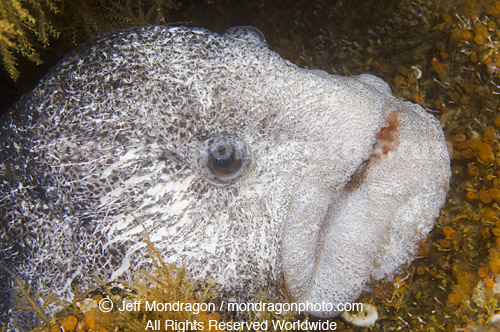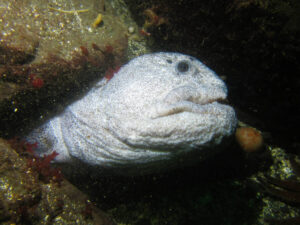


It is rarely eaten so large that overfishing is a problem, but in some parts of the Atlantic, habitat destruction and accidental catches have caused the population to drop a lot. Several kinds of wolffish are in danger because of people. The wolffish doesn’t move around much on purpose because it isn’t very fast and wants to kill its prey as quickly as possible. During most of the day, the wolffish waits patiently in cracks or caves to catch its prey by surprise when it comes by. The Atlantic wolf fish lives between 1,000 and 2,000 feet deep in the Atlantic and Pacific Oceans. The wolffish moves very slowly through the water by moving its whole body back and forth like an eel. Most species have a long dorsal fin that runs the length of the back and another fin that covers most of the stomach and pelvic areas. It has small, simple scales that are almost hidden by the skin. The wolffish has a very long body (up to 7.5 feet), a big head, a long, thin tail, strong jaws, and many rows of teeth, some of which stick out of the mouth even when the mouth closes.īlue, grey, brown, and olive green are the most common colors, and sometimes there are stripes on the side of the body. Nothing about the wolffish makes it more aggressive than any other carnivore, regardless of how pretty it looks. How Does A Wolf Fish Look Like?Īt first glance, these fish look pretty ugly, grizzled, and almost demonic, but their looks can be deceiving. Wolf Eel: This species looks like an eel because of its long body, but it is actually a pure wolffish. The color varies between olive green and brown and has dark spots. Spotted Wolf fish: This species lives on both sides of the North Atlantic Ocean between Russia and Canada. Anarhichas lupus is the scientific name for this species (lupus means wolf in Latin). It also lives in southern places like France and Spain. It has a blue-gray body, a big dorsal fin, and a light underside. It is also called the bull-headed catfish, the Arctic wolffish, and many other names.īering Wolf fish: This species lives around the Pacific coasts of Russia and Alaska, as the name suggests.Ītlantic Wolf fish: This species lives in an area between Greenland, Iceland, the North Sea area, Labrador, Massachusetts, and the coasts of Norway and Russia. Northern Wolf fish is native to the North Atlantic and Arctic Oceans. The most important difference between them is how they look and where they are. Here is a list of the five kinds of wolffish. Four of these species are in the Anarhichas genus, and the wolf eel is the only species in the genus Anarrhichthys. There are five known species of these fish, which belong to two different genera. It has more than 10,000 species, which is about 40% of all bony fish. This is actually one of the groups of animals with the most different kinds.

This seems to come from a Greek word that means “to climb up.” They belong to the order of Perciformes and are most similar to eelpouts, gunnels, and quillfish. The scientific name for the wolffish family of species is Anarhichadidae. minor), also from the North Atlantic, and the black-spotted wolf-eel (Anarhichthys ocellatus), which lives in the eastern Pacific. It lives in the North Atlantic, the spotted wolffish (A. Some of the species have vertical bands, such as in Atlantic wolffish (Anarhichas lupus). They have name catfishes in Europe, and Europeans and Americans eat them. Wolf fish live in water from the shore to at least 300 meters deep. Their powerful teeth are made up of large canines and heavy molars that can handle crabs, starfish, sea urchins, and other prey.īear in mind that wolffish America and wolffish amazon are quite famous.

Wolffish have a big head, a long body that tapers, and a single long dorsal fin on top. The longest species can grow to about 2.3 meters long (7.5 feet). Wolf fish is any of five large, long-bodied fish species in the family Anarhichadidae (order Perciformes) that live in the waters of the northern Atlantic and Pacific.


 0 kommentar(er)
0 kommentar(er)
